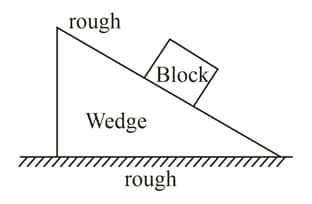When a block is placed on a wedge as shown in the figure, the block starts sliding down and the wedge also starts sliding on the ground. All surfaces are rough. The centre of mass of (wedge + block) system will move



Important Questions on Center of Mass
A small block of mass is placed on bigger block of mass which is placed on a frictionless horizontal surface. The two blocks are given equal speed but opposite directions, as shown in the figure. After some time, it is observed that both the blocks are moving in the direction of motion of the lower block, with a
speed greater than It can be concluded that -

A particle of constant mass moves in straight line under a time varying force. The change in momentum of the particle in a time interval to can be given as
.
The force acting on the particle as a function of time is shown in the graph. If velocity of the particle is zero at , then

Two blocks initially at rest having masses and are connected by spring of spring constant (as shown in the figure). The block of mass is pulled by a constant force and the other block is pulled by a constant force Find the maximum elongation of the spring.

A hemisphere of mass and radius is free to slide with its base on a smooth horizontal table. A particle of mass is placed on the top of the hemisphere. If the particle is displaced with a negligible velocity, then find the angular velocity of the particle relative to the centre of the hemisphere at an angular displacement when the velocity of the hemisphere is .

Two blocks of masses and are connected by spring of constant The spring is initially compressed and the system is released from rest at . The work done by spring on the blocks and be and respectively by time The speeds of both the blocks at time are non-zero.
Then the value of equals to

